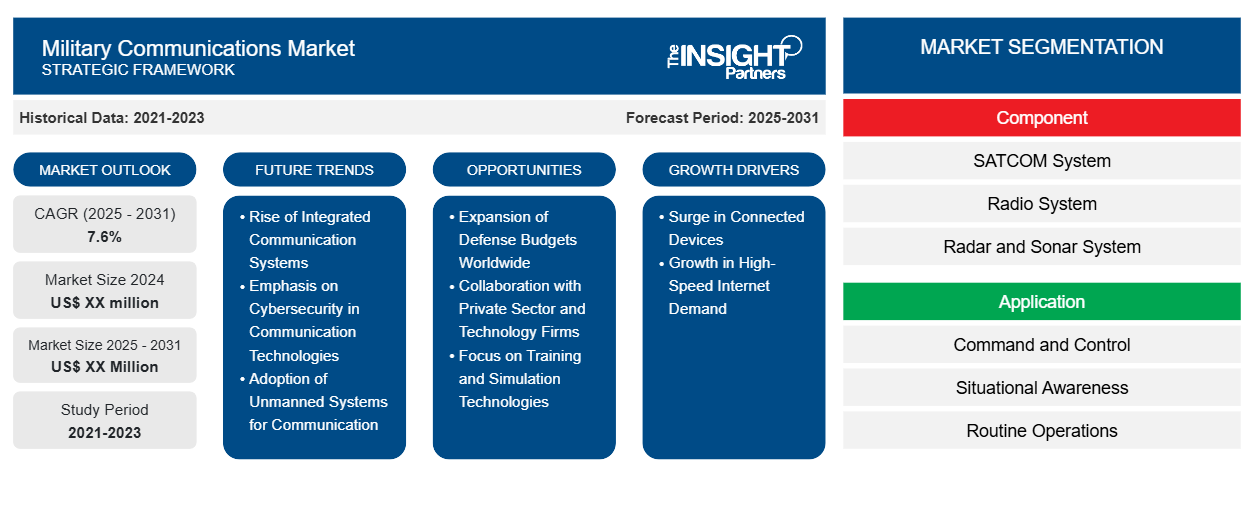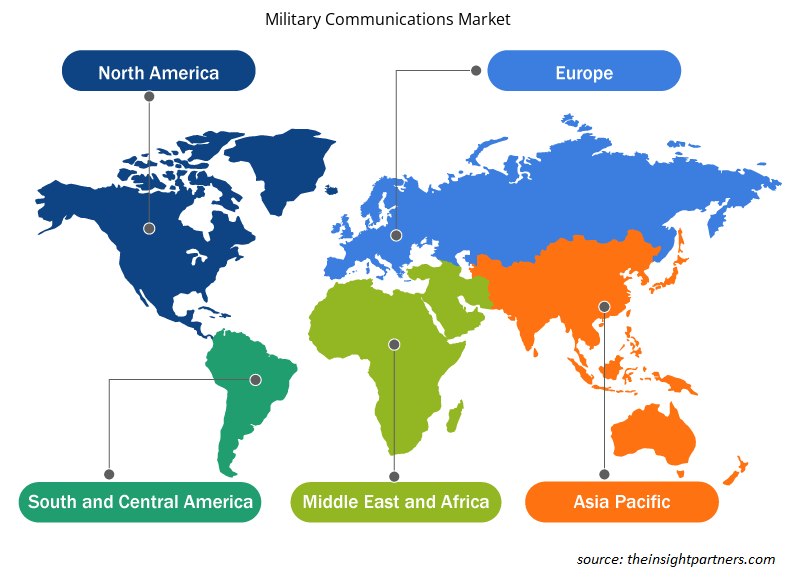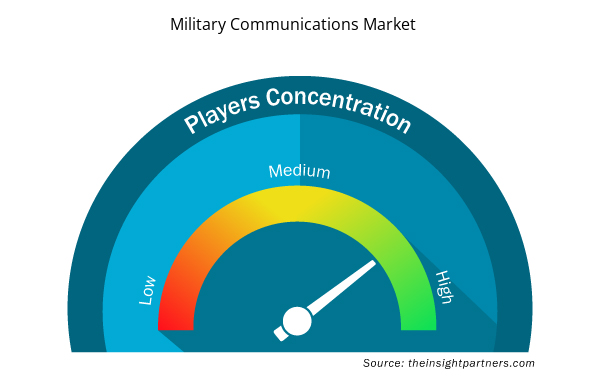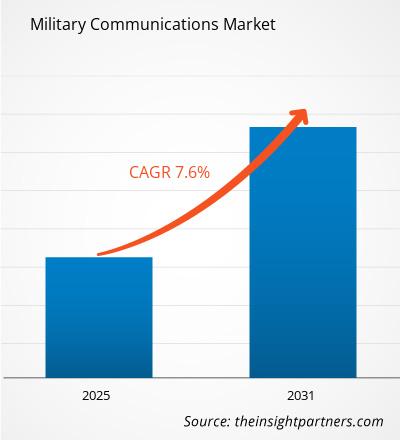The Military Communications Market is expected to register a CAGR of 7.6% from 2025 to 2031, with a market size expanding from US$ XX million in 2024 to US$ XX Million by 2031.
The report is segmented by Component (SATCOM System, Radio System, Radar and Sonar System); Application (Command and Control, Situational Awareness, Routine Operations, Others); End-user (Air Force, Ground Force, Naval Force) . The global analysis is further broken-down at regional level and major countries. The Report Offers the Value in USD for the above analysis and segments.
Purpose of the Report
The report Military Communications Market by The Insight Partners aims to describe the present landscape and future growth, top driving factors, challenges, and opportunities. This will provide insights to various business stakeholders, such as:
- Technology Providers/Manufacturers: To understand the evolving market dynamics and know the potential growth opportunities, enabling them to make informed strategic decisions.
- Investors: To conduct a comprehensive trend analysis regarding the market growth rate, market financial projections, and opportunities that exist across the value chain.
- Regulatory bodies: To regulate policies and police activities in the market with the aim of minimizing abuse, preserving investor trust and confidence, and upholding the integrity and stability of the market.
Military Communications Market Segmentation
Component
- SATCOM System
- Radio System
- Radar and Sonar System
Application
- Command and Control
- Situational Awareness
- Routine Operations
End-user
- Air Force
- Ground Force
- Naval Force
Geography
- North America
- Europe
- Asia Pacific
- Middle East and Africa
- South and Central America
Customize This Report To Suit Your Requirement
You will get customization on any report - free of charge - including parts of this report, or country-level analysis, Excel Data pack, as well as avail great offers and discounts for start-ups & universities
Military Communications Market: Strategic Insights

- Get Top Key Market Trends of this report.This FREE sample will include data analysis, ranging from market trends to estimates and forecasts.
Military Communications Market Growth Drivers
- Surge in Connected Devices: The increasing number of connected devices, driven by the rise of the Internet of Things (IoT) and smart homes, is a major driver for the WiFi chipset market. WiFi chipsets are critical in providing reliable, high-speed connectivity to these devices, including smartphones, smart appliances, wearables, and industrial equipment. As more devices become WiFi-enabled, the demand for WiFi chipsets continues to grow across various sectors.
- Growth in High-Speed Internet Demand: The ongoing demand for faster internet speeds, fueled by the growing adoption of streaming services, online gaming, and data-intensive applications, is propelling the WiFi chipset market. As consumers and businesses require higher bandwidth, WiFi chipsets that support advanced standards like Wi-Fi 6 and Wi-Fi 6E are in high demand, driving growth in the market.
Military Communications Market Future Trends
- Rise of Integrated Communication Systems: There is a notable trend towards the development of integrated communication systems that combine voice, video, and data capabilities into a single platform. This integration allows military personnel to access and share information more efficiently across various communication channels, improving coordination and response times. As defense forces seek to streamline their operations and enhance collaboration, the adoption of integrated systems is becoming increasingly common, paving the way for improved mission success rates.
- Emphasis on Cybersecurity in Communication Technologies: With the growing threat of cyberattacks targeting military networks, there is an increasing emphasis on cybersecurity measures within military communication technologies. Defense organizations are investing in advanced security protocols, threat detection systems, and resilient communication infrastructures to protect sensitive information and maintain operational integrity. This trend reflects the acknowledgment of cybersecurity as a critical component of modern military communications, ensuring that forces can operate securely in an increasingly hostile digital landscape.
- Adoption of Unmanned Systems for Communication: The integration of unmanned aerial vehicles (UAVs) and other unmanned systems into military communications is a prominent trend. These systems are being utilized to extend communication range, gather intelligence, and provide real-time situational awareness in hostile environments. As military forces recognize the advantages of unmanned systems for reducing risks to personnel and enhancing operational flexibility, their adoption is expected to grow, further transforming the landscape of military communications.
Military Communications Market Opportunities
- Expansion of Defense Budgets Worldwide: The ongoing increase in defense budgets across various countries presents significant opportunities for the military communications market. Governments are prioritizing modernization efforts and investing in advanced communication technologies to enhance their military capabilities. This trend is particularly evident in emerging economies, where military expansion and modernization are becoming essential components of national security strategies. The growing defense expenditure creates a favorable environment for market players to introduce innovative communication solutions and technologies.
- Collaboration with Private Sector and Technology Firms: There is a growing opportunity for collaboration between military organizations and private sector technology firms. As the demand for cutting-edge communication solutions rises, military forces are turning to commercial technology providers for expertise in areas such as artificial intelligence, cybersecurity, and advanced communication systems. Such partnerships can drive innovation and accelerate the development of next-generation military communication solutions, benefitting both sectors and enhancing overall military effectiveness.
- Focus on Training and Simulation Technologies: The increasing emphasis on training and simulation technologies offers an opportunity for the military communications market to expand. Effective training programs require robust communication systems to facilitate realistic simulations and real-time feedback. As defense organizations seek to improve the readiness and capabilities of their personnel, investments in advanced training and simulation technologies that incorporate state-of-the-art communication systems will become more prevalent. This growing demand provides a fertile ground for market growth and innovation.
Military Communications Market Regional Insights
The regional trends and factors influencing the Military Communications Market throughout the forecast period have been thoroughly explained by the analysts at Insight Partners. This section also discusses Military Communications Market segments and geography across North America, Europe, Asia Pacific, Middle East and Africa, and South and Central America.

- Get the Regional Specific Data for Military Communications Market
Military Communications Market Report Scope
| Report Attribute | Details |
|---|---|
| Market size in 2024 | US$ XX million |
| Market Size by 2031 | US$ XX Million |
| Global CAGR (2025 - 2031) | 7.6% |
| Historical Data | 2021-2023 |
| Forecast period | 2025-2031 |
| Segments Covered |
By Component
|
| Regions and Countries Covered | North America
|
| Market leaders and key company profiles |
Military Communications Market Players Density: Understanding Its Impact on Business Dynamics
The Military Communications Market market is growing rapidly, driven by increasing end-user demand due to factors such as evolving consumer preferences, technological advancements, and greater awareness of the product's benefits. As demand rises, businesses are expanding their offerings, innovating to meet consumer needs, and capitalizing on emerging trends, which further fuels market growth.
Market players density refers to the distribution of firms or companies operating within a particular market or industry. It indicates how many competitors (market players) are present in a given market space relative to its size or total market value.
Major Companies operating in the Military Communications Market are:
- General Dynamics Corporation
- Airbus
- QinetiQ
- BAE Systems PLC
- Northrop Grumman Corporation
Disclaimer: The companies listed above are not ranked in any particular order.

- Get the Military Communications Market top key players overview
Key Selling Points
- Comprehensive Coverage: The report comprehensively covers the analysis of products, services, types, and end users of the Military Communications Market, providing a holistic landscape.
- Expert Analysis: The report is compiled based on the in-depth understanding of industry experts and analysts.
- Up-to-date Information: The report assures business relevance due to its coverage of recent information and data trends.
- Customization Options: This report can be customized to cater to specific client requirements and suit the business strategies aptly.
The research report on the Military Communications Market can, therefore, help spearhead the trail of decoding and understanding the industry scenario and growth prospects. Although there can be a few valid concerns, the overall benefits of this report tend to outweigh the disadvantages.
- Historical Analysis (2 Years), Base Year, Forecast (7 Years) with CAGR
- PEST and SWOT Analysis
- Market Size Value / Volume - Global, Regional, Country
- Industry and Competitive Landscape
- Excel Dataset


- Truck Refrigeration Market
- Fertilizer Additives Market
- Long Read Sequencing Market
- Rare Neurological Disease Treatment Market
- Identity Verification Market
- Legal Case Management Software Market
- Influenza Vaccines Market
- Antibiotics Market
- Asset Integrity Management Market
- Thermal Energy Storage Market

Report Coverage
Revenue forecast, Company Analysis, Industry landscape, Growth factors, and Trends

Segment Covered
This text is related
to segments covered.

Regional Scope
North America, Europe, Asia Pacific, Middle East & Africa, South & Central America

Country Scope
This text is related
to country scope.
Frequently Asked Questions
Some of the customization options available based on the request are an additional 3–5 company profiles and country-specific analysis of 3–5 countries of your choice. Customizations are to be requested/discussed before making final order confirmation, as our team would review the same and check the feasibility.
The leading players operating in the Military Communications Market include General Dynamics Corporation, Airbus, QinetiQ, BAE Systems PLC, Northrop Grumman Corporation, Collins Aerospace, Lockheed Martin Corporation, RTX Corporation, Thales Group, L3Harris
The global Military Communications Market is expected to grow at a CAGR of 7.6% during the forecast period 2024 - 2031.
Rise of Integrated Communication Systems, Emphasis on Cybersecurity in Communication Technologies, Adoption of Unmanned Systems for Communication is the key future trend of the Military Communications Market
The major factors driving the Military Communications Market is Growing Need for Secure Communication Systems, Technological Advancements in Communication Technologies, Increased Focus on Network-Centric Warfare.
The report can be delivered in PDF/PPT format; we can also share excel dataset based on the request.
Trends and growth analysis reports related to Electronics and Semiconductor : READ MORE..
1. BAE Systems
2. Elbit Systems Ltd.
3. General Dynamics Corporation
4. Inmarsat Plc
5. L3Harris Technologies, Inc.
6. Leonardo S.p.A.
7. Lockheed Martin Corporation
8. Northrop Grumman Corporation
9. Raytheon Technologies
10. Thales Group

 Get Free Sample For
Get Free Sample For